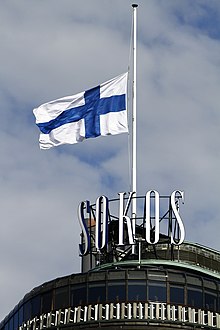
Back تنكيس علم Arabic Trauerbeflaggung German Μεσίστια σημαία Greek Flago ĉe duonmasto Esperanto Media asta Spanish Leinalipp Estonian Makila erdira Basque نیمافراشتگی Persian Suruliputus Finnish Drapeau en berne French


Half-mast or half-staff (American English) refers to a flag flying below the summit of a ship mast, a pole on land, or a pole on a building. In many countries this is seen as a symbol of respect, mourning, distress, or, in some cases, a salute.[1]
The tradition of flying the flag at half-mast began in the 17th century.[citation needed] According to some sources, the flag is lowered to make room for an "invisible flag of death" flying above.[2] However, there is disagreement about where on a flagpole a flag should be when it is at half-mast. It is often recommended that a flag at half-mast be lowered only as much as the hoist, or width, of the flag.[3][4] British flag protocol is that a flag should be flown no less than two-thirds of the way up the flagpole, with at least the height of the flag between the top of the flag and the top of the pole.[5] It is common for the phrase to be taken literally and for a flag to be flown only halfway up a flagpole,[6] although some authorities deprecate that practice.[4]
When hoisting a flag that is to be displayed at half-mast, it should be raised to the finial of the pole for an instant, then lowered to half-mast. Likewise, when the flag is lowered at the end of the day, it should be hoisted to the finial for an instant, and then lowered.[6]
- ^ "Flags at half mast". www.crwflags.com.
- ^ Bartram, G., A Guide to Flag Protocol in the United Kingdom Archived 11 August 2013 at the Wayback Machine, an extract from the book British Flags and Emblems, The Flag Institute.
- ^ "What is the proper etiquette for lowering the flag to half staff?". The Flag Shop. Retrieved 29 May 2017.
- ^ a b "Basic Flag Protocol and Etiquette". Newton Newton Flag & Banner Makers Limited. Archived from the original on 29 August 2003. Retrieved 29 May 2017.
- ^ "Flags at half-staff". The Flag Institute.
- ^ a b "What is the proper procedure to fly your flag at half-staff?". American Flag & Pole Co. Archived from the original on 1 December 2017. Retrieved 29 May 2017.